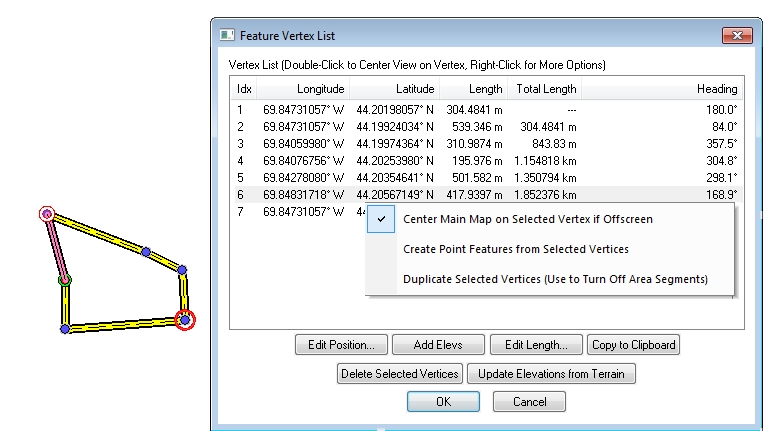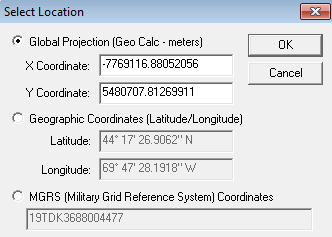
If the Show Area and Line Vertices option is enabled (Shift+V is a keyboard shortcut to toggle this setting), you can also select individual vertices on area and line features. You must select vertices before accessing the Digitizer right-click menu options. With vertices selected, the Digitizer submenu Vertex Editing will appear, with options that allow you to work with individual vertices in area and line features appear in the right-click options menu. Selected vertices will be shown on the display with a circle around them.
To select vertices, simple left click near a vertex to select the closest one if any are nearby, or drag a box to select all vertices within the box. The same behavior modifications occur as described above if the CTRL and/or SHIFT keys are pressed when selecting. If you hold down the 'S' key when left clicking, only vertices from already selected lines or areas will be considered.
The options in the Digitizer right-click menu under Vertex Editing include:
Selecting this optionbrings up the Feature Vertex List dialog (below). In this dialog
vertex position, elevation and segment length may be edited. 
Select a vertex from the list to see the segment and vertex highlighted on the map display. The selected vertex may be edited with the buttons.
Edit Position
Modify the X and Y coordinates of the currently selected vertex. For more assistance with this dialog see
Add Elevs
Add or modify the elevation value of the currently selected vertex. If there is no Z or Elevation column in the vertex list, per vertex elevations have not been enabled. There will first be a prompt to enable per vertex elevations and create this column. It will automatically populate all vertices with any existing feature elevation attribute.
The elevation unit will be displayed in the column heading. The unit interpretation of the elevation numbers can modified in theElevations and Heights
Edit Length
Specify the length of the subsequent line segment. This will update all subsequent vertex locations.
Copy to Clipboard
The feature vertex list will be copied to the windows clipboard in comma delimited format.
Delete Selected Vertices
The selected vertex will be removed. Other vertex attributes will update to reflect the change in length and heading.
Update Elevations from Terrain
If a digital elevation model is loaded into the workspace and visible, the elevation of the vertices may be edited to match by selecting the option to Update Elevations from Terrain.
Right-clicking on a selected vertex in the Feature Vertex List will provide a list of options:
Center Main Map on Selected Vertex if Offscreen
This is enabled by default, and set the same for all vertices. When a vertex is highlighted in the list, the 2D map display will center on the selected vertex if it is offscreen. Double clicking on a vertex in the list will also center the map display on the vertex.
Create Point Feature from Selected Vertex
A new point feature will be created from the selected vertex location. It will inherit the attributes of the original line or area feature, include the vertex elevation.
Duplicate Selected Vertices (Use to Turn Off Area Segments)
The selected vertex will be duplicated. Duplicate vertices can be used to turn off the border style for part of the area feature, so there is also a prompt to specify whether to turn of drawing at the duplicated segment.
For example, when drawing a shoreline from a large water body made up of multiple area features, duplicate vertices at the start of the shoreline can turn on border drawing, then a duplicate vertex at the segment abutting the other pieces of the lake along the shore, can turn off the border drawing, so there are no lines intersecting the water body.
These right-click context menu options require per vertex elevations:
Apply an Offset to the Selected Elevation
Add an elevation value to the existing vertex value. The units are displayed in the Feature Vertex list in the Elevation column label.
Apply a Scale Factor to the Selected Elevations
Multiply the existing vertex elevation by a number to scale the value.
Evenly Spread Elevations Between First and Last Elevation
The elevation values will be evenly spread along the length of the area feature to maintain a consistent slope from the first elevation to the last.
Interpolate Elevations to Replace 0 values
Replaces existing vertex elevations that are 0 with an elevation value to provide a consistent slope between the neighboring vertices. Distance to the neighboring vertices is factored into the interpolated elevation value.
Reverses the order of all vertices in a selected line or area feature.
Split Selected Area(s) at Selected Vertices
Simplify
(Reduce) Vertices of Selected Line/Area Features(s)
Smooth Selected
Line/Area Features(s)
Allows the selected vertex to be moved with a left click at a
new location.
Delete
Selected Vertices
Allows the user to specify
location for selected Vertices using the 'Set Location' dialogue (below).

Choosing this will select the next vertex in the selected line or area feature, useful if all vertices in a feature need to be edited.
Choosing this will select the previous vertex in the selected line or
area feature.
Changes the cursor
function, allowing the user to insert and additional vertex into the selected
line or area feature with a left click of the mouse.